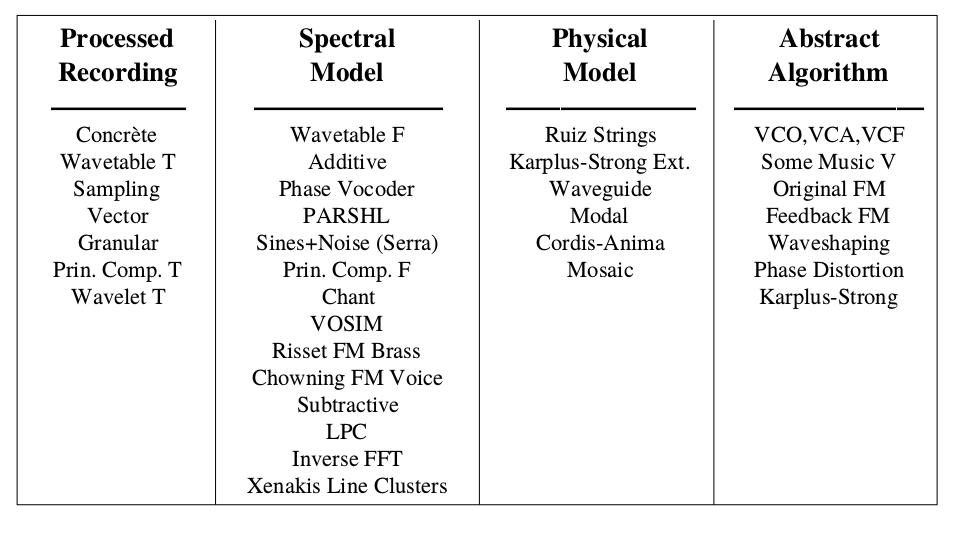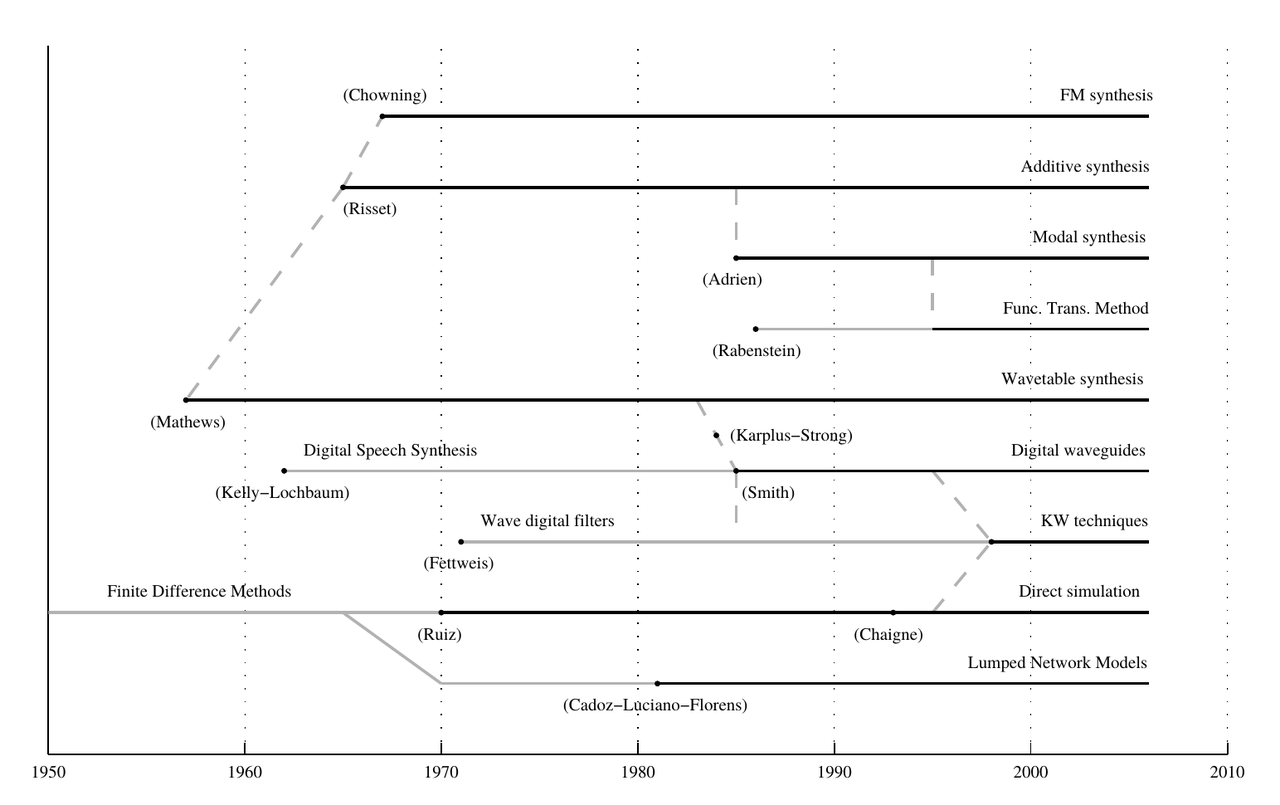Digital Synthesis: History & Taxonomy
Taxonomy
Digital methods for sound synthesis can be grouped according to their underlying principle of operation. In 1991, Smith proposed four basic categories, shown in [Fig.2].

- Fig.2
-
Taxonomy of synthesis algorithms (Smith, 1991).
Processed Recording
Already a technique in the analog domain, more precisely in Musique Concrète, this family of synthesis approaches makes direct use of previously recorded sound for synthesis. This can be the playback of complete sounds or the extraction of short segments, such as grains or a single period of a sound.
Spectral Models
Spectral models use mathmatical means for expressing the spectra of sounds and their devopment over time. They are usually receiver-based, since they model the sound as it is heard, not as it is produced. This paradigm already existed in the mechanical world, as used by Hermann von Helmholtz in the 19th century and is based on even older signal models.
Physical Models
Physical Models are based on virtual acoustical and mechanical units, realized through buffers and LTI systems. Oscillators, resonating bodies and acoustic conductors are thus combined as in the mechanical domain. Physical modeling is regarded a source-based approach, since it deals with the actual sound production.
Abstract Algorithm
If it is not processed sound, a spectral model or a physical model, it is an abstract algorithm. Algorithms from this category transfer methods from other domains, like message transmission, to the musical domain.
Missing Recent Approaches
Although a few categorisations could be debated, the above introduced taxonomy is still valid but misses some recent developments. Methods based on neural networks and deep learning for sound generation may be considered a fifth taxon.
Family Tree
The synthesis experiments at Bell Labs are the origin of most methods for digital sound synthesis. [Fig.1] illustrates the relations for a subset of synthesis approaches, starting with Mathews. The foundation for many further developments was laid when John Chowning brought the software MUSIC VI to Stanford from a visit at Bell Labs (Chowning, 2011). After migrating it to a PDP-6 computer, Chowning worked on his groundbreaking digital compositions, using the FM method and spatial techniques.

- Fig.1
-
Evolution and family tree (Bilbao, 2009).
2011
- John Chowning.
Turenas: the realization of a dream.
Proc. of the 17es Journées d’Informatique Musicale, Saint-Etienne, France, 2011.
[details] [BibTeX▼]
2009
-
Bilbao, Stefan.
Numerical Sound Synthesis.
Wiley Online Library, 2009.
ISBN 9780470749012.
doi:10.1002/9780470749012.
[details] [BibTeX▼] - Ananya Misra and Perry R Cook.
Toward Synthesized Environments: A Survey of Analysis and Synthesis Methods for Sound Designers and Composers.
In Proceedings of the International Computer Music Conference (ICMC 2009). 2009.
[details] [BibTeX▼] - Tae Hong Park.
An interview with max mathews.
Computer Music Journal, 33(3):9–22, 2009.
[details] [BibTeX▼]
1991
- Julius O. Smith.
Viewpoints on the History of Digital Synthesis.
In Proceedings of the International Computer Music Conference, 1–10. 1991.
[details] [BibTeX▼]
1988
- Miller S. Puckette.
The patcher.
In Proceedings of the International Computer Music Conference (ICMC). 1988.
[details] [BibTeX▼]
1986
- Emmanuel Favreau, Michel Fingerhut, Olivier Koechlin, Patrick Potacsek, Miller S. Puckette, and Robert Rowe.
Software developments for the 4x real-time system.
In Proceedings of the International Computer Music Conference (ICMC). 1986.
[details] [BibTeX▼]
1980
- Curtis Roads and Max Mathews.
Interview with max mathews.
Computer Music Journal, 4(4):15–22, 1980.
[details] [BibTeX▼]
1969
1963
- Max V Mathews.
The Digital Computer as a Musical Instrument.
Science, 142(3592):553–557, 1963.
[details] [BibTeX▼]
